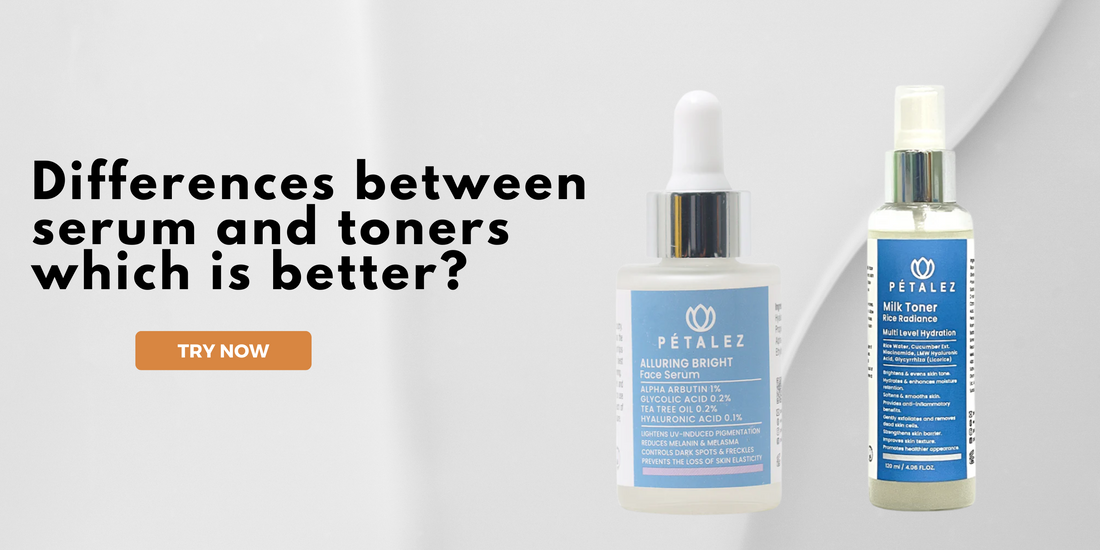
Differences between serum and toners which is better?
Share
Choosing the right skincare products can make a big difference in how your skin looks and feels. Many people are confused about what products to use and in what order. Serum and toner are two common items that often get mixed up or skipped altogether. But understanding their roles can help you create a routine that really works. This article aims to clear up the confusion and help you decide which product—serum or toner—is better for your skin type and goals.
Definition and Purpose of Toner
A toner is a liquid treatment usually used after washing your face. Its main job is to remove leftover dirt or oil and restore your skin’s natural balance. Think of it as a prep step that gets your skin ready for moisturizer or serum. It often has ingredients that help tighten pores or hydrate the skin, depending on what kind you choose.
Types of Toners and Their Benefits
- Hydrating Toners: Contain ingredients like hyaluronic acid or aloe to boost moisture.
- Astringent Toners: Often have witch hazel or alcohol. They are great for oily skin because they help tighten pores.
- Clarifying Toners: Designed for acne-prone skin. They include salicylic acid or tea tree oil to fight breakouts.
How to Incorporate Toners Effectively
Apply toner right after cleansing. Use a cotton pad or your hands to gently pat it onto your skin. For oily or acne-prone skin, a more frequent routine might help, while sensitive skin benefits from less frequent use. Pick a toner suited to your skin's needs — it’s all about targeting your concerns.
Definition and Purpose of Serum
A serum is a highly concentrated liquid packed with active ingredients. It’s like a supercharged treatment that targets specific skin issues. Whether you're fighting wrinkles, dark spots, or dullness, serums are designed to deliver powerful results fast.
Types of Serums and Their Benefits
- Anti-aging Serums: Loaded with antioxidants and peptides to reduce fine lines.
- Brightening Serums: Contain vitamin C to give your skin a healthy glow.
- Acne-fighting Serums: Use niacinamide or salicylic acid to clear pimples and reduce oiliness.
How to Use Serums for Maximum Effectiveness
Apply serum after cleansing and toning. Place a few drops onto your fingertips, then gently pat it onto your face. Layer it under moisturizer for added benefits. Use serums depending on your skin needs—more often if you’re targeting specific issues, less if your skin is sensitive.
Differences Between Serum and Toner
Composition and Concentration
Toners are usually light and water-based, with lower concentrations of active ingredients. In contrast, serums contain higher levels of active ingredients, making them more potent.
Functions and Targets
Toners primarily focus on balancing and refreshing the skin, preparing it for other products. Serums go deeper, tackling specific concerns like aging, dullness, or spots with targeted treatments.
Application Order in Skincare Routine
Cleanse your skin first. Then, apply toner to restore pH and prep. Follow with serum to treat specific issues. Finish with moisturizer to lock everything in. Using them in this order maximizes their benefits.
Cost and Investment
Serums tend to be more expensive because they are highly concentrated. They deliver quicker and more visible results but may require a bigger investment. Toners are usually affordable and act more as a prep step or basic treatment.
Which Is Better? Factors to Consider
Skin Type and Concerns
- Oily or acne-prone skin: Astringent toners help control oil. A serum with salicylic acid can clear breakouts.
- Dry skin: Hydrating toners boost moisture. Serums with hyaluronic acid or glycerin add extra hydration.
- Sensitive skin: Choose gentle, alcohol-free toners. Light serums with calming ingredients like chamomile work well.
Ingredient Preferences and Sensitivities
Always check ingredient labels. Avoid products with allergens or harsh chemicals. If you have allergies, consulting a dermatologist can help pick safe options.
Skincare Goals and Routine Compatibility
Both products can work together. Use toner daily to keep your skin balanced. Add serums as needed for specific concerns. Sometimes, prioritizing one over the other makes sense, especially if time or budget is limited.
Expert Recommendations and Industry Insights
Skincare pros recommend using toner to prep skin and serums for targeted treatments. Consumer trends show people are increasingly opting for multi-step routines that include both products.
Actionable Tips for Choosing Between Serum and Toner
- Do patch tests before trying new products to avoid irritation.
- Focus on your main skin concerns first.
- Read labels carefully—know what ingredients are in your products.
- Incorporate new products gradually into your routine.
- Consult skincare professionals if unsure about what fits your skin best.
Conclusion
Understanding the main differences between serum and toner helps you create a more effective skincare routine. Toners mainly prep and balance your skin, while serums provide powerful, targeted treatment. Both serve unique roles, and using them correctly can improve your skin’s health and appearance. Your ideal routine depends on your skin type, concerns, and goals. Don't hesitate to experiment or seek professional advice to find what works best.
FAQs About Serum vs. Toner
Can I skip toner and use serum directly?
Yes, but toner helps remove residual impurities and balances skin pH, making serums more effective. For oily/acne-prone skin, toner is especially beneficial.
Can I layer serum and toner? What’s the correct order?
Order: Cleanser → Toner → Serum → Moisturizer.
Exception: Hydrating toners can sometimes be used after serum for deeper absorption.
Are toners with alcohol bad for dry skin?
Yes. Dry/sensitive skin should avoid alcohol-based toners. Opt for hydrating toners with hyaluronic acid or rose water.
Can I use both serum and toner for acne?
Yes! Pair a salicylic acid toner (to unclog pores) with a niacinamide serum (to reduce inflammation).
Which is better for aging skin—toner or serum?
Serum wins. Look for retinol or peptide serums. Toners with antioxidants (green tea) can support but aren’t as potent.
Why does my serum pill when applied after toner?
Solution: Let toner dry completely, or switch to a thinner, alcohol-free toner. Pilling often occurs with silicone-based serums.

